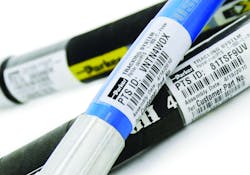High-pressure hydraulic systems are an integral part of airport ground support equipment (GSE), such as auxiliary power units, loading systems, deicers, and runway and taxiway snowplows. This equipment is built to meet tough 24/7/365 aircraft and airport service demands. But, should a system go down, and a high-pressure hydraulic hose is the source of the problem, Parker research has found that getting a replacement assembly can be a nightmare for the maintenance crew for these reasons:
- A lack of knowledge/training as to the type of fluid in the hydraulic system and hydraulic hose in general as well as the handling and safety issues/requirements…
- Generally, replacement hydraulic hose is not carried in the maintenance inventory…
- No knowledge of where to quickly get the correct replacement assembly made, or having to wait for a replacement hose from the equipment OEM…
This article provides reference to hydraulic hoses used in GSE equipment, along with important safety instruction for injection injuries of hydraulic fluid from pinhole leaks in the hose.
High-pressure hydraulic hose applications
Auxiliary power units (APUs) use phosphate ester-based fluid conveyed through braided and spiral EPDM hose and transferred onto the aircraft.
Loading systems have hydraulics for lifting/lowering, conveying, driving, and steering/braking using both braided and spiral high-pressure hoses.
Deicers use glycol fluid conveyed through braided and spiral hydraulic hose. Petroleum-based fluid is used with the same hose for pressure applications.
Runway and taxiway snowplows use hydraulic systems to power plow movement. Petroleum-based fluid is used with braided hydraulic hose.
Do not mix and match components
The safest, highest quality hydraulic hose assemblies are made with the correct components from the same manufacturer. When improper or incompatible hoses and fittings are combined, the risk of unanticipated problems and costs increases. Components from different manufacturers should never be combined to create hose assemblies.
Simplify hose assembly component selection with the STAMP process (size, temperature, application, media, pressure).
Size: The “dash number” – the measure of a hose’s inside diameter (ID) – is an industry designation used to identify the size of a hydraulic hose or fitting. This identifier is found on the hose layline, or stamped on a fitting. Record the overall assembly length and fitting orientation before cutting the hose. Choosing parts with the correct ID is important for maintaining proper system flow velocity.
Temperature: Ambient temperature measures the temperature of the environment in which the hose is used. System temperature is the temperature of the media being conveyed.
Media temperatures can have a negative impact on hose materials. Rubber, for example, loses flexibility if subjected to high temperatures for extended periods of time. To help prevent damage resulting from media temperatures that are too high or too low, hoses are designated with temperature ratings for different types of fluids.
Application: Will the hose encounter excessive movement or contact with rough surfaces? What will be the bend radius if space is tight? For maximum service life and safety, a hose assembly should be routed so that the hose is not stretched, compressed or kinked. Allow for a minimum straight length of twice the hose’s outside diameter between the end of the fitting and the point at which the bend starts. Know industry standards and requirements concerning hose construction type, size, tolerances, working pressure, and impulse cycles for the application.
Media: The inner tube, cover, and fittings of a hose assembly must be compatible with the media being conveyed. For ground support equipment, that can vary from petroleum-based fluids for pressure applications to glycol fluid in deicing equipment, and phosphate ester-based fluid in APUs.
Pressure: It is critical to know both the system working pressure and the pressure of any surges or spikes in the system. The published maximum working pressure of the hose must be greater than the pressure the system can surge to. This information is provided on the hose layline.
Safety solutions – Planning and prevention
Hydraulic fluid injection injuries can result in tissue damage, amputation, and death. Advance planning for prevention and treatment is critical. Should an injury occur, there is no time for prep — it has already passed.
Fluids in high-pressure applications can escape from pinhole leaks in hoses caused by a number of factors including: age, incompatible fluids, hose twist, and minimum bend radius violations. These pressurized fluids travel at bullet speed and can penetrate deep under the skin. Yet, the injured person may feel only a slight pricking sensation. Rarely does the initial pain indicate injury severity. What looks like a simple puncture wound is life threatening. Hydraulic fluids contain a wide range of chemical compounds that are highly toxic within the bloodstream.
Immediate treatment required. Hydraulic fluid can quickly destroy tissue, leading to gangrene and amputation (as occurs in nearly half of all instances). Rushing the injured person to the nearest hospital may not be adequate. Medical professionals classify an injection injury as a surgical emergency. But because the wound looks harmless, the treatment protocol often given is “Low” instead of “Critical” priority.
Note that many doctors are not experienced in treating injection injuries. Plan ahead for proper treatment by locating a practiced caregiver (a hand surgeon is best). Then, issue wallet cards with the name, address and phone number of the medical facility and/or surgeon. On the card’s back, list the type, amount and pressure of the fluid injected as well as the exact time, body location, and penetration angle of the injury.
To ensure safety, employees should never come close to fluid power hoses and fittings when the system is pressurized. The most common cause of injection injury is using hands or fingers to detect leaks. Thick leather gloves offer little protection — pinhole-size leak can propel fluid at 600+ feet-per-second. To perform a visual inspection, shut down the system. If a system must remain pressurized, or when hoses are routed in hard-to-see locations, use a pole with a piece of cardboard attached to check for leaks.
Eric McCarthy is product manager for Parker Hannifin Corporation, Hose Products Div. He gave a presentation on this topic at the Cygnus Aviation Expo in Las Vegas.




